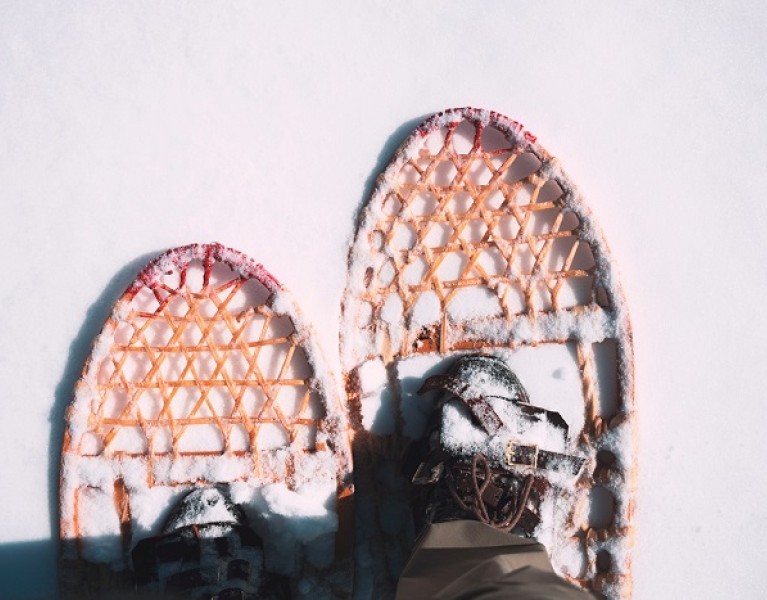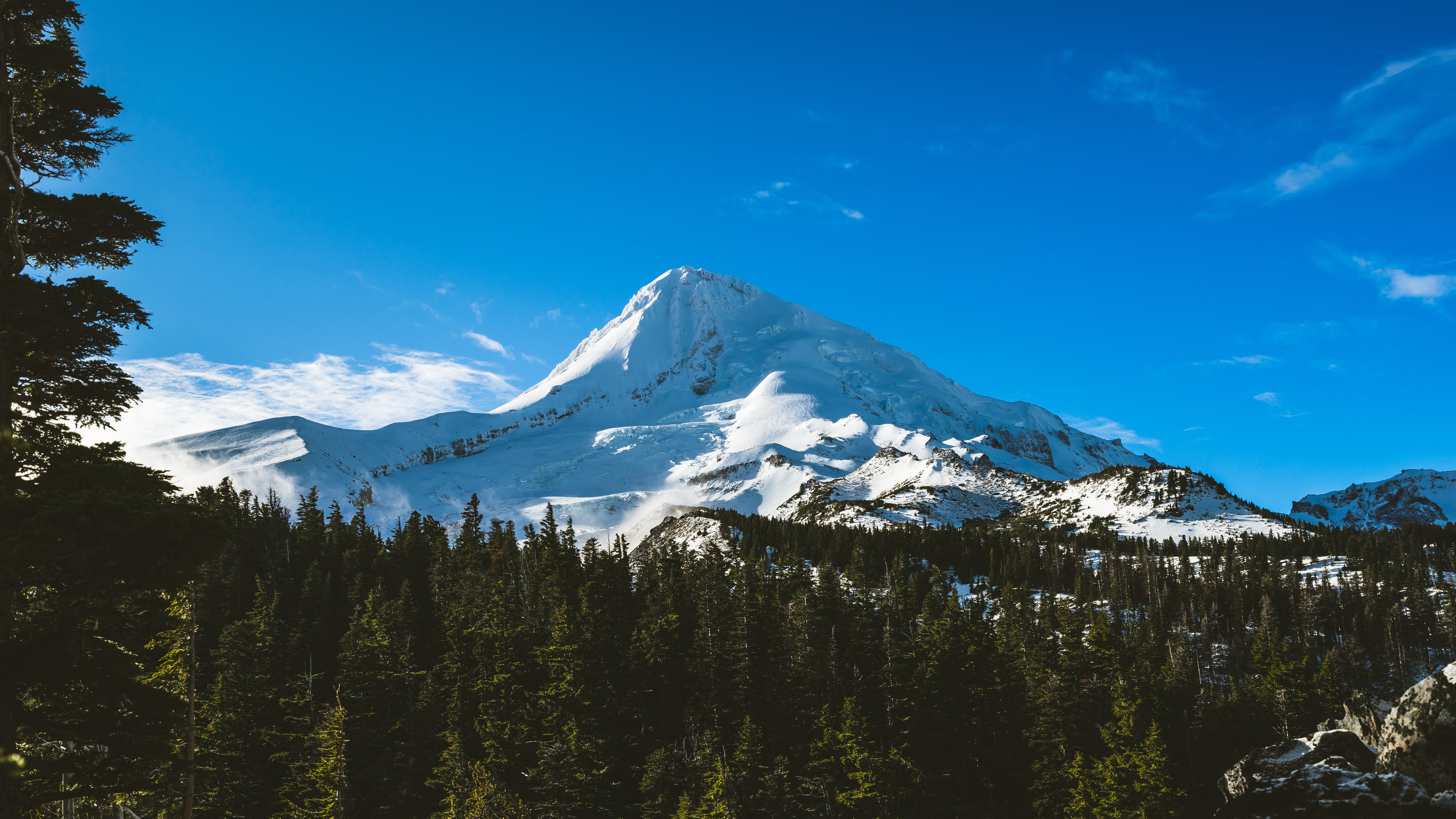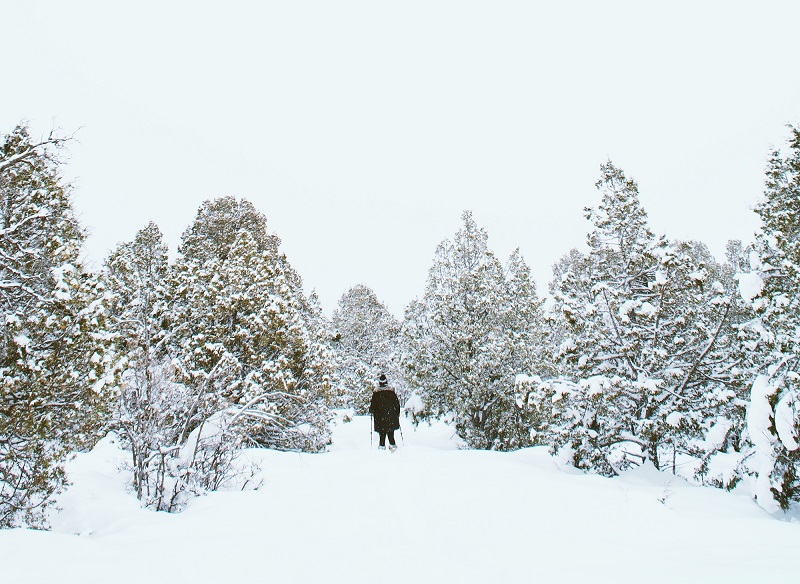
Snowshoeing: All-Access Winter Sport
Table of Contents [Show]
Snowshoes! Ok, what image just came to mind?
If you're like I was several years back, you're probably picturing a scruffy-bearded old-school trapper laboring along a half-frozen river on long, awkward, wood-and-sinew snowshoes. You know, the kind you see hanging over a fireplace at a rustic-themed steakhouse or that two-bedroom rental cabin you and twenty of your closest friends piled into last year.
Then again, also like me, you've seen their modern counterparts in sporting goods catalogs and your favorite outdoor adventure store. And maybe—and this was definitely me—you thought, "Man. That looks like a lot of work."
I thought I might take up Nordic skiing when I moved to this remote mountain town, but the closest thing we have to groomed cross-country trails are roughly-plowed backroads with potholes big enough to hide a cryptological lake monster. My winter exercise routine consisted of daily snow shoveling and chucking hay to my goats—great upper-body workouts—but unless I wanted to go wading up to my neck through the woods or across sparkling white pastures, I felt that my only options were snowmobiling or ice fishing... both activities with pretty high break-in costs.
And then a friend invited me to go snowshoeing, and I thought, what the heck? Even if I didn't enjoy it, I could at least get an idea as to whether or not snowshoes would help me with my winter chores, or allow me to get to my truck when I just didn't feel like shoveling the path.
Getting Geared Up
As easy as it is to find a snowshoe rental shop in most towns with actual winters, we don't have any around here. But my friend Aaron, a retired wildlife biologist, scored a deal on several cheap, bottom-of-the-barrel pairs from a shop that was updating its rental inventory. "Bring your ski poles. And your boots," Aaron told me when I accepted his invitation.
"What kind of boots? Do I need special boots?" I was getting concerned. He knew I was a noob, right?
"Any waterproof, breathable lace-up outdoor boots." I looked online and, sure enough, midweight hiking boots were among the most popular choices for snowshoers, followed by old-school Sorel Caribou-type winter boots. I have both, but I went for the former. I also chose my favorite outdoor gear based on what I use for cold-weather hiking:
- Gaters
- Snowshoeing clothing - KÜHL Akkomplice performance base bottom and zip-neck top
- Snowshoeing pants - KÜHL Jetstream rain pants
- Breathable rain shell
- Performance fleece hoodie
- Wool hiking socks (I'm a wool girl when it comes to socks.)
- Polarized sunglasses
- A warm hat that covers my ears
I also grabbed a pair of thin insulated gloves and tossed my "hell hath frozen over" mittens in my daypack. You don't have to be new to snowshoeing to understand basic backcountry gear, including first aid supplies and emergency equipment. Plus, a backpack's a great place to stash outer layers when you're breaking a sweat on the trail.
Wearing the wrong shoes and clothes can make or break an experience, which is why I spend my money on stuff designed by actual outdoor experts. I shop from dedicated outdoor stores that have excellent customer support in case things just don't work out. There's just no excuse to put up with the wrong gear.
Plus, on this trip, I wanted to focus on whether or not plastic paddles strapped to my feet were "my thing", not whether my pants were going to give me a bad case of cameltoe.
At Aaron's, he made sure to set me up with a pair of snowshoes that fit my boots. "You don't want them sliding around and causing you to mess up your ankles," he explained as I checked out the stabby-looking metal cleats sticking from the snowshoes' undersides.

Breaking Trail
Once Aaron was satisfied I had the right fit, we drove out to a fire road with an easy grade for my first outing. He knows I'm in decent shape, but he warned me that snowshoes take some getting-used-to and he wanted me to learn how to use my poles to stand up (he actually pushed me over when I wasn't expecting it) and how to walk backward (awkward!). After some stretching, we set off, and I was amazed at how quickly I adjusted my gait to accommodate my "new" feet.
The purpose of snowshoes, of course, is to distribute your weight over the snow's surface. On that day, the two-foot-deep snow had a light crust to it. Aaron said a lot of people like to start out in soft, fluffy, fresh-fallen snow, and I learned why: A couple times, we broke through and "post-holed" into the softer snow beneath the crust when I had to wiggle my feet to pull them back out, requiring a bit more coordination, balance, and energy.
The fire road paralleled a slow-moving, half-frozen stream. We didn't feel compelled to fill the quiet with small talk, and our pace and silence kept us from spooking birds and animals we might otherwise not have seen: That day we saw tons of birds, a fox, a marten, a couple whitetail does, and—in a meadow across the water—a small herd of elk.
I considered how snowshoes could open up my winter wandering options: The woods behind my house, which I usually abandoned between Thanksgiving and St. Paddy's Day. The neighbor's gently rolling hayfield. The decommissioned railroad bed that rambled through town.
I realized I could stash them behind the seat of my truck for last-minute trips to the local ski resort which, like many across the continent, wisely opened up their lifts to the growing number of snowshoeing enthusiasts.
This snowshoeing thing doesn't suck, after all, I thought.
The Inevitable "What Snowshoes Should I Buy" Conversation
After about 90 minutes of hiking, we stopped for lunch. It was crisp and cold and, in spite of breaking a mild sweat with the effort, I still felt dry, thanks to my choice of clothing. I decided I really could get into this sport, and considered the cheap plastic snowshoes I'd borrowed.
I asked Aaron about his fancy pair, and if they made much of a difference. "It depends," he said. "Those old rentals will work fine if you're only going to go out a couple times a year." He kicked up his left foot, showing off an aluminum frame spanned by a rigid plastic material. "These are all-around snowshoes, not even $200 new," he said. "They're a bit more flexible, and they're a bit broader and longer than yours."
Later, he e-mailed me a link to a site that explained and reviewed snowshoeing gear, including the best entry-level snowshoes. I read about "rotation" and "float" and how they applied to snowshoeing equipment, but the learning curve in choosing different styles wasn't all that intimidating.

Aaron went on to describe the different types of shoes for different needs: Backcountry, carrying large packs, incline, ice, crust, and traversing powder, for starters. He even told me about insane people who run in snowshoeing marathons. My new mentor advised purchasing a pair with built-in crampons to tackle icy conditions and told me that most decent entry-level gear would suit most recreational snowshoers.
"You had a pretty good day, even with those crappy old things," he said, gesturing at the scuffed up plastic slabs stuck to my boots. Point taken.
Once we'd finished our lunch, Aaron and I headed back to the trailhead at an easy, lazy pace. I imagined what it would have been like to wear those old, oversized handmade monsters... not to mention heavy animal skin coats and bulky home-spun clothing. All while packing elk quarters, rifles, and Lord knows how many pounds of chewing tobacco. I bet snowshoeing wasn't much fun back in the day, and that those old-timers would be shocked at how popular recreational snowshoeing has become over the last decade or so.
Tech is pretty awesome, I thought, as I stopped for a selfie with Aaron.
Featured image by Aaron Huber


